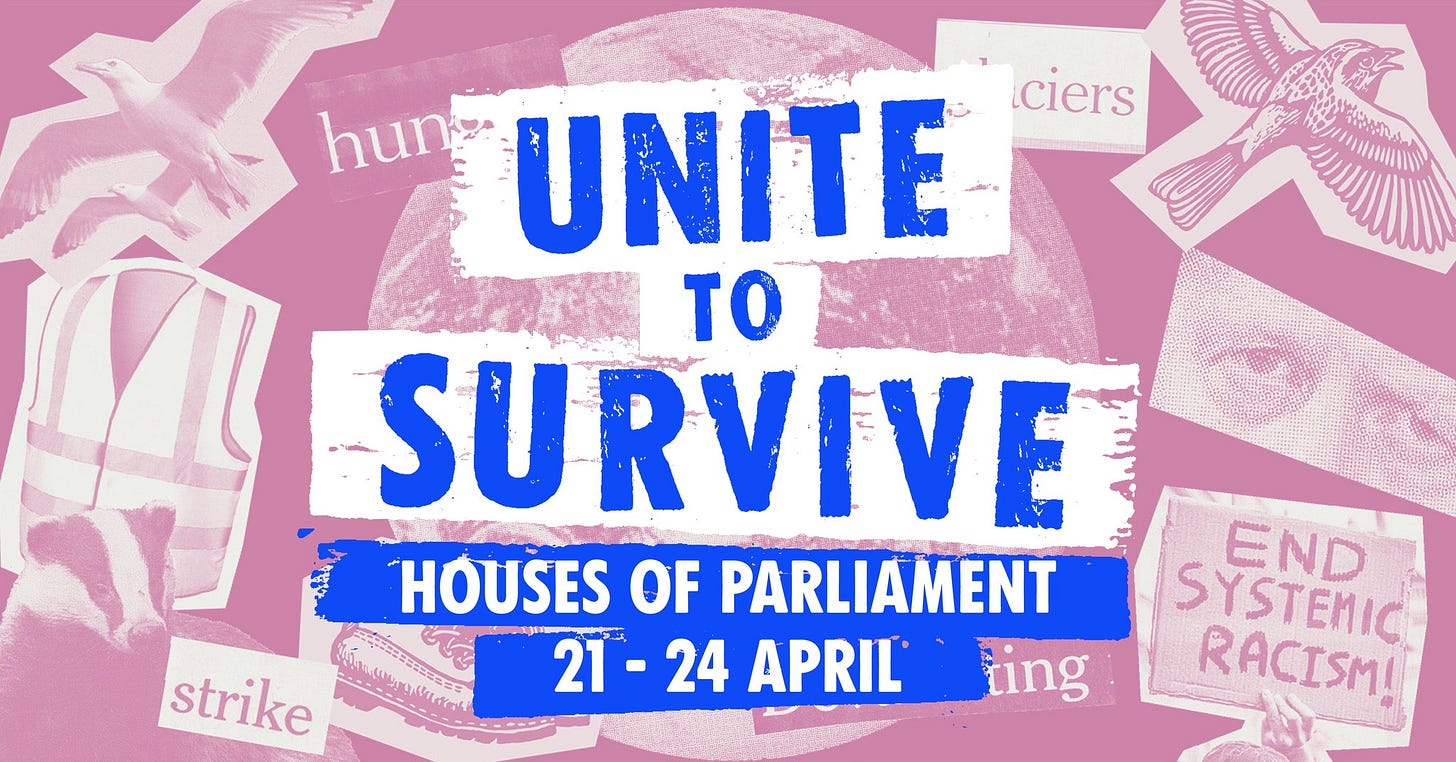21 April 2023. Climate | Art
Extinction Rebellion does the politics of mass mobilisation // Stopping trawlers through activist art.
Welcome to Just Two Things, which I try to publish three days a week. Some links may also appear on my blog from time to time. Links to the main articles are in cross-heads as well as the story. A reminder that if you don’t see Just Two Things in your inbox, it might have been routed to your spam filter. Comments are open. Have a good weekend!
1: Extinction Rebellion does the politics of mass mobilisation
Extinction Rebellion’s planned big protest this weekend around the British Houses of Parliament represents a change of tactics. The group intends to get 100,000 people to the area over the next four days for what they call “The Big One”—a number that might or might not become a hostage to fortune.
But: the emphasis here is on turning up, not on non-violent resistance, civil disobedience, and arrest. They have support from 94 other organisations. It is a shift to more traditional forms of political mobilisation and political protest, in other words.
This is the first expression of the organisation’s new approach, announced at the end of December:
(W)e make a controversial resolution to temporarily shift away from public disruption as a primary tactic... What’s needed now most is to disrupt the abuse of power and imbalance, to bring about a transition to a fair society that works together to end the fossil fuel era... This year, we prioritise attendance over arrest and relationships over roadblocks, as we stand together and become impossible to ignore.
At Novara Media, they’re running a ‘mini-series’ on XR. Clare Hymer has an article specifically about the thinking behind this shift in tactics.
First, in terms of climate change politics, we’re not in the same world that we were in in 2018, when XR was formed. There’s much greater public awareness of climate change and its dangers, partly because of the success and visibility of XR’s protests. Smaller more nimble offshoots, such as Insulate Britain and Just Stop Oil, have taken on direct action and disruption. There’s a space in the political landscape for a mass climate movement, in other words.
At the same time, the initial tactics of being willing to be arrested had put a ceiling on what the organisation could do—you runs out of people who are that committed—as well as attracting criticism for its colour-blindness:
”At the beginning, there was a lot of criticism that we were, you know, glorifying arrest, which was alienating for a lot of people – people of colour, people like myself”, says Nick Anim, who got involved in XR in 2019. “This shift is very much hoping to address that.”
This shift hasn’t been uncontroversial inside XR. There are still activists who believe that the urgency of the climate moment requires disruption. But what sits behind it is a different approach to the politics of mobilisation:
With the help of Becky Bond, former advisor to Bernie Sanders, and Joe Todd, previously at Momentum, the group arrived at the idea of ‘deep canvassing’: knocking on people’s doors and listening to their concerns... Since the start of 2022, Jones estimates activists have knocked on over 50,000 doors and had around 20,000 conversations about the climate crisis. Over time, Project 3.5 developed a three-step plan to get 100,000 people on the streets in order to “trigger” that 3.5% to join them: knock on a door and have a chat, ask them to attend a short talk in their local area about the plan and how to get involved, then follow up with a phone call.
Project 3.5 was an internal XR project based on the work of the political scientist Erica Chenoweth, who has done a vast survey of protest movements globally, and found that the active support of 3.5% for a campaign movement was typically the threshold of success. It’s likely that XR has misunderstood this number, because these protests “involved ‘resistance to repressive regimes or occupations, or in support of secession’” but maybe that’s a distraction from the wider idea of engagement and mobilisation.
'Deep canvassing’ was hard work and had erratic results, but did energise local groups and have the effect of ‘normalising’ XR activists among the people they talked to. Building connections to organisations such as Greenpeace was done in parallel.
(The pink boat in Oxford Circus. Source: Extinction Rebellion)
One of the other things that has changed since 2018 has been the response of the police and authorities to the protests. The police have got greater powers than they had then, and they have better intelligence. One of the results of that is that it’s harder to use structures like the pink boat at Oxford Circus to help secure an area.
“We can’t bring in infrastructure like we used to,” (XR’s Clare) Farrell explains. “People just get nicked at home, before they’ve even gone out with it. Or the warehouse gets raided, or you get pulled over, or you get stopped on the street and all your stuff taken off you (…) So it’s a difficult design challenge to work out how to create operational resilience in the space.”
All the same, this isn’t a conventional protest march. It’s about being visible in the centres of power.
“I’m a strong believer that marches don’t do that much,” says (XR organiser Alanna) Byrne. “It’s by either refusing to go home, or coming back day after day, that we’ll create enough pressure that change will ultimately come.” In recent weeks, however, the timescale has been limited to 21-24 April, raising questions about whether four days is long enough to have the desired effect.
It may not work, of course. And Chenoweth’s research seems to suggest that civil resistance needs to be sustained, so it might be that XR needs to find different ways to engage this wider group of climate activists.
I take a couple of things away from this. The first is that XR has probably earned the credibility to organise events such as “The Big One” through its sustained campaigns of disruption since 2018. Those were a necessary building block.
The second is that those critics of XR who said that their disruption model was limited were right. I’m thinking of people like Nafeez Ahmed, who were supporters of XR, and other climate groups, but said—in a long piece—that its initial strategy was based on “flawed social science”. Some of this is a misunderstanding of the dataset in Chenoweth’s research.
Both she, and separately the political scientist Gene Sharp, found that non-violent resistance was less effective in liberal democracies. And Chenoweth’s work with Stephan notes that successful movements use a whole range of strategies:
Of the 323 cases they study, all of them involved opposition forces using a wide range of different strategies with mass arrests figuring as just one potential approach — that would only work in the right circumstances. Most successful cases required a wide diversity of strategies building on years of community mobilisation.
It feels as if this latest turn is an acknowledgment that XR needs to develop a richer collection of strategies that reach more people. And we need an effective mass climate movement using whatever tactics work to keep pressure on governments for change.
I’m also reminded, perhaps oddly, or perhaps just optimistically, of an article that John Berger wrote in 1968 about the purpose of the mass demonstration. The fit is not quite right—he saw the mass demonstration as part of a rehearsal for revolutionary change—but some of the sensibility makes sense:
The larger the demonstration, the more powerful and immediate (visible, audible, tangible) a metaphor it becomes for their total collective strength. I say metaphor because the strength thus grasped transcends the potential strength of those present, and certainly their actual strength as deployed in a demonstration. The more people there are there, the more forcibly they represent to each other and to themselves those who are absent. In this way a mass demonstration simultaneously extends and gives body to an abstraction. Those who take part become more positively aware of how they belong to a class.
And this piece is already too long, but there’s not enough discussion of the role of class in climate change. I’m hoping to come back to that next week.
2: Stopping trawlers through activist art
What’s the best way to stop deep sea trawlers from fishing illegally in coastal waters and destroying the marine ecosystems? It turns out that it might be to create an underwater art gallery by commissioning a collection of ten tonne marble sculptures and placing them on the seabed.
I liked the analogy about deep sea chain fishing from the Tuscany fisherman who had campaigned against the deep sea trawlers for thirty years, and whose idea this was:
Trawling is not a sustainable way of fishing. The chains drag over the seabed, and if we put the chains on, it’s like a Caterpillar (bulldozer). It’s like a hunter burning down the entire forest to catch one boar.
This story tells a fascinating story of how Paolo the fisherman (that’s how he’s described in the film) evolved different strategies over time—including direct action, marine tourism, and eventially eco-activist art: “art that does something”. But it’s also a tribute to commitment, persistence, and the power of story and gift.
This nine minute film, presented by Safy-Hallan Farah and directed by Giorgio Blanco, is part of Patagonia’s ‘Art of Activism’ series.
Other writing: travel
Patrick Leigh-Fermor’s book A Time of Gifts, which describes his walk as a teenager across Europe just before World War II, is a classic travel book, and deservedly so. I wrote a review on my Around the Edges blog. It tells a story of a different world. Here’s an extract:
There’s a deeper thought that sits behind this, and that is the sense of how much one would have been thrown on one’s own resources on a trip like this. He has some locations and dates on which he can collect money that has been wired from home. But there are few public phones, and few English speakers—although his German is passable. You were pretty much on your own.
(Photo: Andrew Curry, CC BY-SA-NC 4.0)
j2t#448
If you are enjoying Just Two Things, please do send it on to a friend or colleague.





